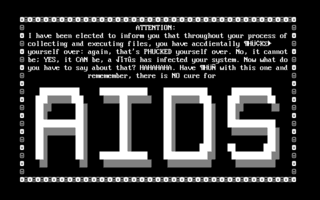
Malware is any software intentionally designed to cause disruption to a computer, server, client, or computer network, leak private information, gain unauthorized access to information or systems, deprive access to information, or which unknowingly interferes with the user's computer security and privacy. Researchers tend to classify malware into one or more sub-types.

This timeline of computer viruses and worms presents a chronological timeline of noteworthy computer viruses, computer worms, Trojan horses, similar malware, related research and events.

CIH, also known as Chernobyl or Spacefiller, is a Microsoft Windows 9x computer virus that first emerged in 1998. Its payload is highly destructive to vulnerable systems, overwriting critical information on infected system drives and, in some cases, destroying the system BIOS. Chen Ing-hau, a student at Tatung University in Taiwan, created the virus. It was believed to have infected sixty million computers internationally, resulting in an estimated US$1 billion in commercial damages.
Bagle was a mass-mailing computer worm affecting Microsoft Windows. The first strain, Bagle.A, did not propagate widely. A second variant, Bagle.B, was considerably more virulent.
Acme is a computer virus which infects MS-DOS EXE files. Each time an infected file is executed, Acme may infect an EXE in the current directory by creating a hidden 247 byte long read-only COM file with the same base name. Acme is a variant of Clonewar, a spawning virus. Acme is also perhaps a descendant of the small single-step infector Zeno, which is not to be confused with the Zeno programming language.
Ada is a computer virus that can affect any of the DOS operating systems. Ada was first discovered in 1991.

AIDS is a DOS computer virus which overwrites COM files.

WinFixer was a family of scareware rogue security programs developed by Winsoftware which claimed to repair computer system problems on Microsoft Windows computers if a user purchased the full version of the software. The software was mainly installed without the user's consent. McAfee claimed that "the primary function of the free version appears to be to alarm the user into paying for registration, at least partially based on false or erroneous detections." The program prompted the user to purchase a paid copy of the program.
Jerusalem is a logic bomb DOS virus first detected at Hebrew University of Jerusalem, in October 1987. On infection, the Jerusalem virus becomes memory resident, and then infects every executable file run, except for COMMAND.COM. COM files grow by 1,813 bytes when infected by Jerusalem and are not re-infected. Executable files grow by 1,808 to 1,823 bytes each time they are infected, and are then re-infected each time the files are loaded until they are too large to load into memory. Some .EXE files are infected but do not grow because several overlays follow the genuine .EXE file in the same file. Sometimes .EXE files are incorrectly infected, causing the program to fail to run as soon as it is executed.
Westwood is a computer virus, a variant of the Jerusalem family, discovered August 1990, in Westwood, Los Angeles, California. The virus was isolated by a UCLA engineering student who discovered it in a copy of the "speed.com" program distributed with a new motherboard. Viral infection was first indicated when an early version of Microsoft Word reported internal checksum failure and failed to run.
Scott's Valley [sic] is a computer virus, a member of the Slow virus family and distantly related to the Jerusalem virus family. It was discovered in September 1990 in Scotts Valley, California.
Sunday is a computer virus, a member of the Jerusalem virus family. It was discovered in November 1989 after a number of simultaneous reports from Seattle, Washington, United States, and surrounding areas. Several other Seattle outbreaks, including AirCop, were later traced to Asia.
Alabama is a computer virus, discovered in October 1989 on the campus of the Hebrew University of Jerusalem.
Ontario is a family of computer viruses, named after its point of isolation, the Canadian province of Ontario. This family of computer virus consists of Ontario.1024, Ontario.512 and Ontario.2048. The first variant Ontario.512 was discovered in July 1990. Because Ontario.1024 was also discovered in Ontario, it is likely that both viruses originate from within the province. By the Ontario.2048 variant, the author had adopted "Ontario" as the family's name and even included the name "Ontario-3" in the virus code.

Stoned is a boot sector computer virus created in 1987. It is one of the first viruses and is thought to have been written by a student in Wellington, New Zealand. By 1989 it had spread widely in New Zealand and Australia, and variants became very common worldwide in the early 1990s.

A computer virus is a type of computer program that, when executed, replicates itself by modifying other computer programs and inserting its own code into those programs. If this replication succeeds, the affected areas are then said to be "infected" with a computer virus, a metaphor derived from biological viruses.
Gumblar is a malicious JavaScript trojan horse file that redirects a user's Google searches, and then installs rogue security software. Also known as Troj/JSRedir-R this botnet first appeared in 2009.
MS Antivirus is a scareware rogue anti-virus which purports to remove virus infections found on a computer running Microsoft Windows. It attempts to scam the user into purchasing a "full version" of the software. The company and the individuals behind Bakasoftware operated under other different 'company' names, including Innovagest2000, Innovative Marketing Ukraine, Pandora Software, LocusSoftware, etc.
Sality is the classification for a family of malicious software (malware), which infects files on Microsoft Windows systems. Sality was first discovered in 2003 and has advanced over the years to become a dynamic, enduring and full-featured form of malicious code. Systems infected with Sality may communicate over a peer-to-peer (P2P) network to form a botnet for the purpose of relaying spam, proxying of communications, exfiltrating sensitive data, compromising web servers and/or coordinating distributed computing tasks for the purpose of processing intensive tasks. Since 2010, certain variants of Sality have also incorporated the use of rootkit functions as part of an ongoing evolution of the malware family. Because of its continued development and capabilities, Sality is considered to be one of the most complex and formidable forms of malware to date.
ANTI is a computer virus affecting Apple Macintosh computers running classic Mac OS versions up to System 6. It was the first Macintosh virus not to create additional resources within infected files; instead, it patches existing CODE resources.







